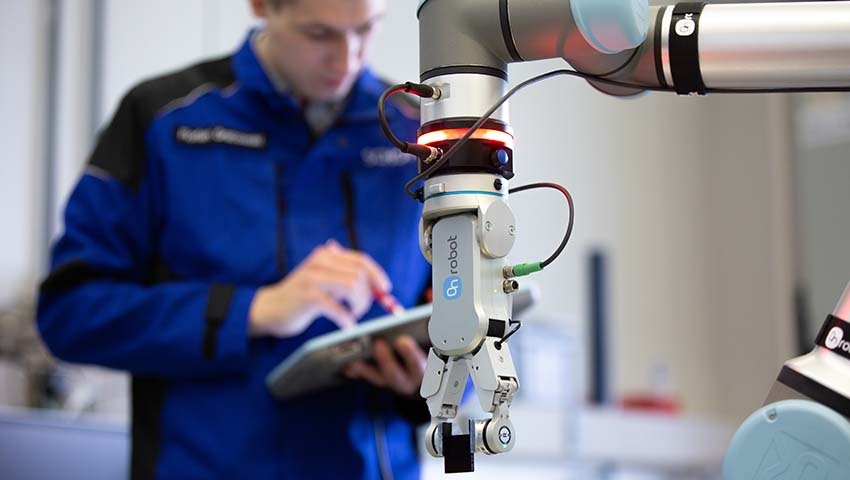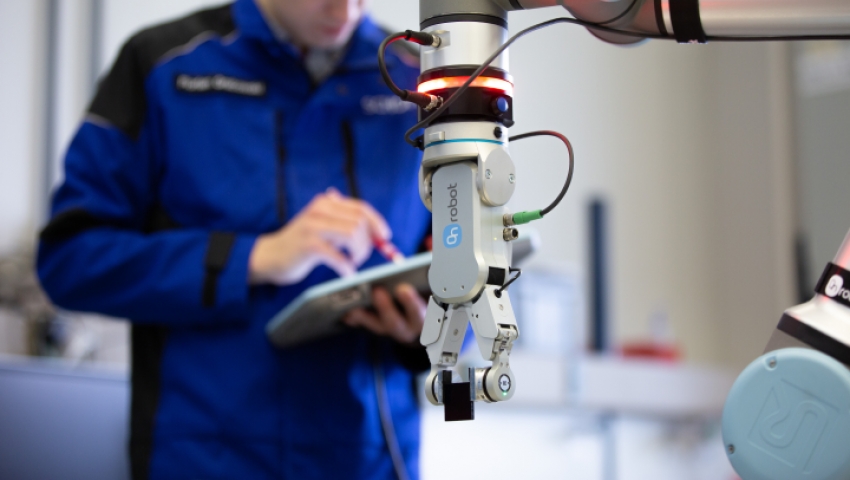SCHOTT AG automates quality inspection with OnRobot

|
Automating Quality InspectionsSee all Off-the-Shelf Solutions "In the last three years, the volume of samples here in the laboratory has increased by about 30 percent," reports Dr. Engel from SCHOTT, a leading international technology group in the areas of speciality glass and glass-ceramics. The ChallengeThis posed several challenges for the manager and his team: SCHOTT needed more capacity to test so many samples in the time available. However, additional measuring equipment and personnel would only have limited space in the limited laboratory space. In addition, it took the employees a lot of time to load the measuring device. A measurement takes between three and 15 minutes, after which the employees have to interrupt other activities in order to insert a new sample. This is where the idea of automating the measuring process first came up. "We put a lot of time and effort into selecting a suitable automation solution," recalls Dr. Engel. "The solution had to be space-saving and be able to work right next to the laboratory technicians. A conventional industrial robot was out of the question: it would have needed an additional protective enclosure, and there is no room for that". There was also another difficulty: the measuring device, a so-called transmission spectrometer, which records the optical properties of the glass, is extremely sensitive. Inserting the samples in such a way that the expensive device is not damaged requires great sensitivity. "After looking at solutions from various manufacturers, we finally found what we were looking for in OnRobot," reports Dr. Engel. Solution: RG2-FT gripper with a sense of touchSCHOTT decided on an application in which an RG2-FT gripper from OnRobot is mounted on a collaborating robot arm. The special thing about the electric two-finger gripper is that both force/torque sensors and optical sensors are located in its fingertips. These enable the gripper to "think along": The sensors feed their process data back to the robot arm, which adjusts its course accordingly. This enables the gripper to precisely meter the force applied to the arm. This gives the application as a whole the necessary sensitivity to load the spectrometer with millimetre precision. Also, the fingertips got customized. They consist of aluminium and are coated with foam rubber to grab the individual glass samples perfectly. The benefits of automating with collaborative applicationsNow the applications not only runs through the nights but also during the weekend. As a result, the application has handled most of the samples before the laboratory employees come into work. Therefore, the laboratory technicians directly benefit from the application. They do not need to insert the glass samples into the spectrometer manually – they can focus on elaborate test reports. Dr. Engel is satisfied with the pilot project: "With the application, we can work much more efficiently and relieve our employees," he sums up. Thanks to the rapid integration and smooth processes, the application also promises a rapid ROI: "We expect the purchase to pay for itself within five to six months".
|


Automating Quality Inspections
"In the last three years, the volume of samples here in the laboratory has increased by about 30 percent," reports Dr. Engel from SCHOTT, a leading international technology group in the areas of speciality glass and glass-ceramics.
The Challenge
This posed several challenges for the manager and his team: SCHOTT needed more capacity to test so many samples in the time available. However, additional measuring equipment and personnel would only have limited space in the limited laboratory space. In addition, it took the employees a lot of time to load the measuring device. A measurement takes between three and 15 minutes, after which the employees have to interrupt other activities in order to insert a new sample. This is where the idea of automating the measuring process first came up.
"We put a lot of time and effort into selecting a suitable automation solution," recalls Dr. Engel. "The solution had to be space-saving and be able to work right next to the laboratory technicians. A conventional industrial robot was out of the question: it would have needed an additional protective enclosure, and there is no room for that". There was also another difficulty: the measuring device, a so-called transmission spectrometer, which records the optical properties of the glass, is extremely sensitive. Inserting the samples in such a way that the expensive device is not damaged requires great sensitivity. "After looking at solutions from various manufacturers, we finally found what we were looking for in OnRobot," reports Dr. Engel.
Solution: RG2-FT gripper with a sense of touch
SCHOTT decided on an application in which an RG2-FT gripper from OnRobot is mounted on a collaborating robot arm. The special thing about the electric two-finger gripper is that both force/torque sensors and optical sensors are located in its fingertips. These enable the gripper to "think along": The sensors feed their process data back to the robot arm, which adjusts its course accordingly. This enables the gripper to precisely meter the force applied to the arm. This gives the application as a whole the necessary sensitivity to load the spectrometer with millimetre precision. Also, the fingertips got customized. They consist of aluminium and are coated with foam rubber to grab the individual glass samples perfectly.
The benefits of automating with collaborative applications
Now the applications not only runs through the nights but also during the weekend. As a result, the application has handled most of the samples before the laboratory employees come into work. Therefore, the laboratory technicians directly benefit from the application. They do not need to insert the glass samples into the spectrometer manually – they can focus on elaborate test reports. Dr. Engel is satisfied with the pilot project: "With the application, we can work much more efficiently and relieve our employees," he sums up. Thanks to the rapid integration and smooth processes, the application also promises a rapid ROI: "We expect the purchase to pay for itself within five to six months".
About SCHOTT
SCHOTT is an internationally leading technology group with more than 16,200 employees worldwide. The company’s founder Otto Schott was a pioneer in the field of modern glass science, who established the special glass industry as a new industrial sector. For 130 years, the name SCHOTT has been associated with innovative solutions in terms of specialty glass and glass ceramics. Whether in aerospace, medical technology or the automotive industry, the diverse products of SCHOTT AG are used in almost all areas of life.

